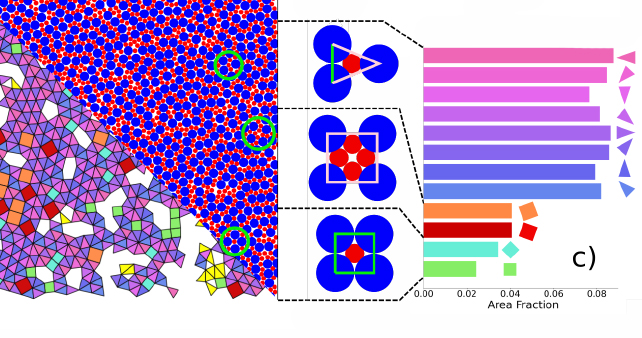Footage of thousands of tiny metal spheres set jiggling in a shallow tray has revealed an arrangement of particles once considered impossible.
A team of physicists from the University of Paris-Saclay in France has observed an unusual combination of order and chaos known as a 'quasicrystal' emerging spontaneously in a granular material on a millimeter-scale for the first time.
If there is beauty in order, crystals are the very manifestation of elegance and attraction.
Quasicrystals, on the other hand, are the awkward siblings scientists denied even existed for the longest time.
Then in the early 1980s, an analysis of an alloy of aluminum and manganese revealed the undeniable hallmarks of an ordered material that lacked the infinite periodic patterns of a crystal.
It was a pseudo-crystal … a material that breaks the rules of symmetry thought to constrain the solidified arrangement of atoms as either crystals or jumbled messes.
Since then, quasicrystals have popped up in a variety of places – from the laboratory to the field to the heavens above. Though still far from common, it's a structure that isn't as forbidden as physicists once thought, forming spontaneously from particles on a variety of scales, including among objects easily rearranged with a jiggle.
This raises some interesting questions on limits of particle size and conditions under which the right kinds of material might self-assemble into a quasicrystal pattern.
Starting with computer simulations, the researchers identified a relationship of sphere sizes and a ratio of small-to-large particles, making up a mixture that could potentially fall into arrangements that reflect a long-range quasicrystal symmetry.

This was used as the basis of an experiment that combined 3,840 non-magnetic steel spheres of two different diameters – one just under 2.4 millimeters, the other half that size – in a shallow container.
Set to vibrate at a rate of 120 times a second, there was little else to do but film the shaking using a setup that maps the 2D arrangements of particles.
After a week of jostling, the researchers had a good measure of the appearance of small, localized configurations of small and large metal beads, and the ways these 'tiles' repeated over time and across the container.
"An interesting picture seems to emerge," the researchers note in their report, which is currently on the preprint server arXiv.com, awaiting peer-review.
"Tiles of the desired shapes form very rapidly, probably as a consequence of their efficient local packing. However, global alignment requires much more collective rearrangements that appear to be rare events."
Finding quasicrystals form in similar ways under both small, atomic-scale and more granular, millimeter-scale systems is something the team didn't expect. In fact, according to the study's senior author, theoretical physicist Giuseppe Foffi, the experiment all began as something of a wager.
"This was born as a bet with a colleague who said it would not work, but I said why not try it, it could be interesting," Foffi told New Scientist's Karmela Padavic-Callaghan.
With their unusual symmetry and quirky patterning over long distances, quasicrystals could have a variety of applications in insulation and electronics.
They might not have all the perfect looks of a crystal, but the awkward sibling definitely has a charm all of its own.
This research was published on arXiv.
Scientists Vibrated a Box of Particles And They Formed a Strange New Material - ScienceAlert
Read More

No comments:
Post a Comment